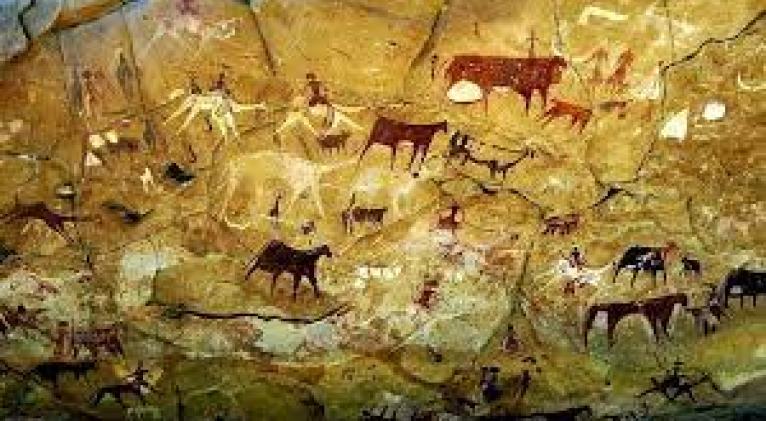Challenging Gender Stereotypes: Evidence Next to the Mammoth
especiales

The fact that pink is for Girls and blue is for Boys, it seems more and more ancient. But it does not mean that gender stereotypes have been erased from the collective imaginary.
In everyday life, especially in subjectivities - where it’s more difficult to modify prejudices-, continues to project that Women are the fair sex, ideals for domestic chores and the cares.
It must be hard to undo those and other gender approaches, if even when referring to prehistory, texts, even academics, and also illustrations have recreated women only collecting, sewing or cooking, dedicated to motherhood and waiting in caves or camps the return of the triumphant hunter with his prey.
However, an interesting study that included experimental approaches, confirms that, from Paleolithic times, women were gaining empowerment.
Historical injustice?
In the videoconference, what have we been told us and what do we know now? The role of the woman in the evolution of our species, the young doctor in Human Evolution, Paleoecology of the Quaternary and Geophysical Techniques Applied to investigation, Olalla Prado Nóvoa, argues about the performance of women in the prehistory of humanity, very different to what is usually said.
But this researcher at the Institute of Biology and Environmental Sciences of The University of Aberdeen, in Scotland, would not be happy to know that this is the synthesis of what was his doctoral thesis.
Thus it can be inferred because she herself clarified at her conference given last year: “… Maybe what should be done is stop fussing every time a piece of news about evidence that women hunting, or could be the authors of the rock paints.
“What should be done is to normalize this type of discoveries because we have never had evidence otherwise. And, of course, it’s very important that we change the language to stop talking about the evolution of man and start drawing a prehistory again in which women are shown as an active part of the groups: making tools, dominating the fire, hunting, making art and being active continuously, even during motherhood ... "
Certainly, there is no evidence to demonstrate what so far has been repeated, also in schools, multiplying what could be described as historical injustice.
It has been so because, according to the researcher, because most archaeologists and anthropologists, when these sciences were born, were white and wealthy men. And their gender views, marked by the reality they had to live in the nineteenth century, biased those approaches and conclusions, awarding certain roles to those women, as inherent to their biology, which until today have repeated androcentric prejudice.
But the inquiries of Dr. Prado Nóvoa found that women preferably took care of activities that were transporting weight, used to carry more loads than men.
"We found," she said- that the only difference between individuals, as for the loading of weights, it was not due to the fact of being a man or woman, but to differences due to body size ”.
By furthering in such a strategy that women were the ones carrying weights, the expert commented that women, while carrying those weights, collected resources that cost less to achieve, thus enabling men
to focus on hunting larger preys.
“In conclusion, what we can see is that women dedicated different time and energy to search, obtain and transport resources according to the skill of men to be more or less successful while hunting.
This will determine that the food collection is improved, the efficiency of the entire group, and, therefore, the general survival of them all".
Moms of the Quaternary
As for pregnancy, breastfeeding and the transfer of young, traditionally interpreted as impediments, the specialist pointed out that in such circumstances it was likely that women had less success by hunting than men, hence they then dedicated themselves to collection of plant resources and maybe hunt small animals.
It’s a sort of temporary specialization that described as intelligent and necessary considering that men were the part of the population whose mortality was linked to hunting, was going to have less repercussions on the survival of the group and its permanence.
To answer the question of whether pregnancy meant a restraining for women in prehistory, considering that this is assumed as a demanding physiological state and with a high metabolic energy cost, they deployed an experimental design - they had already used one to the issue of loads- that allowed them to ensure that “undoubtedly, women had a continuously active role during the past, regardless of their physiological state. ”
It was also very interesting to demonstrate, she added that the sexual division of work is a totally necessary cooperation product to promote efficiency, and, consequently, the survival of a group.
“So when we talk about the past, the important thing is to stop stating that activities were much more relevant than the others for our evolutionary success and assume that if there was a division of tasks
every day by sex, it was not because women and men had different capacities, but because in certain situations it’s the best way to get organized".
That’s why archaeological evidence shows that there was that division of work, but the evidence of the many things women and men did in common in the past are far greater, hence interesting and necessary are these studies to tear down myths, the researcher sentenced.
Translated by Amilkal Labañino / CubaSí Translation Staff














Add new comment